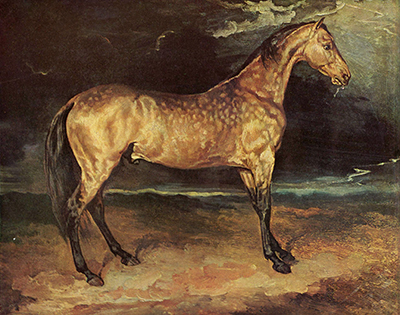A Horse Frightened by lightning by is a painting by Theodore Gericault, dated 1810 – 1812. It is an animal painting whose medium is oil on canvas. Its dimensions are 48.90 cm by 60.30 cm. The painting is displayed at and owned by National Gallery London.
Initially, the painting shows a still horse that looks frightened and without a sense of belonging. The horse appears abandoned and stray. The expressions mean to say that if the horse knew its way back, it would be probably running home. In the background is the onset of a torrential downpour, and the streaks of lightning are not a pleasant sight. The sky is covered with thick clouds. Horses have reduced visibility in darkness, which adds to its confusion. In the first image, the horse's front legs are quite together, and its posture doesn't suggest any response with motion, hence confirming its indecisiveness and confusion.
A Horse Frightened by lightning by is a sombre painting, with a dark-brown tone and an old-fashioned look. The horse lacks shoes and is without a collar rope, which probably tells us that it was stray, and perhaps without an owner's care. The Horse is in the upcountry, yet no traces of humanity seen. The ground is pathless, and in the distant is the sea. There is a deep sense of loneliness and solitude that sweeps the viewers, coupled with solitude.
Horses were the most reliable means of transport over long distances then and were highly valued possessions. Losing a horse would be a source of distress and a step backward in terms of social standing, which was probably the painter’s inspiration. Horses were also a measure of wealth and added to one’s honour. The painting not only shows the state of the horse but also floods the viewer's mind with a deep concern for the owner. The owner's state is paralleled to the viewer’s mood. The horse helps in predicting the owner’s climate, who is probably upset about its whereabouts.
At the same time, he's deterred by the impending rain, which makes him distressed, and the horse desperate. The mood changes in another image, which shows the horse turning, followed a picture of the horse speeding in the opposite direction. A sense of awareness and direction comes on site, and the horse seems to have realised the remedy. The aspect of running shows a deliberate and calculated intention developed during the stillness period. The image teaches us to respond to situations with calmness, followed by careful and intentional decision making. Taking a turn when we reach a dead, instead of responding with hysteria is another quality that’s displayed.




